Physical Address
304 North Cardinal St.
Dorchester Center, MA 02124
In the words of Mercer Rang, “children are not small adults.”
The popularity of youth sports continues to grow and increasing participation of children at younger ages is being seen. Approximately 30 to 44 million preadolescents and adolescents are involved in organized sports, and an estimated 7.6 million students are involved in high school athletics. This participation is beneficial to the overall health of these children but is not without risk. Previous surveys estimated the annual number of injuries resulting from participation in sports and recreational activities to be 4,379,000; of these, 1,363,000 were classified as serious (i.e., requiring hospitalization, surgical treatment, missed school, or a half day or more in bed). A recent analysis of high school athletes demonstrated an estimated 446,715 severe injuries involving the knee (29%), ankle (12.3%), and shoulder (10.9%) most commonly. Of these injuries, 36% were fractures. Slightly more than half of the severe sports injuries resulted in medical disqualification for the season, and approximately a quarter of the injuries required surgical intervention.
In a separate study, Swenson and collegues found an incidence of 10% fractures in high school athletes, and an increased proportion of fractures were inversely associated with maturity of the player. Fracture rates were highest in football, ice hockey, and lacrosse, and the hand/finger (32.1%), lower leg (10.1%), and wrist (9.5%) were affected most commonly.
Enacted in 1972, Title IX legislation was designed to increase participation of females in sports, which it has done. The increase in female sports participation has brought a disproportionate increase in female injuries, and in gender-comparable sports, girls have a higher injury rate than boys. In sports that involve running and cutting, jumping, and landing, females have been shown to sustain higher rates of knee injuries than males. Moreover, Frisch and colleagues also found an association with sports injury and previous injury between the two genders, but highlighted that girls were more likely to sustain an injury in team sports compared with boys in racquet sports. Although they found no difference in the severity of sports injuries between genders, they did find an increased incidence of foot and ankle injuries in girls. Girls may have a higher risk of injury; thus, this gender is often targeted by injury prevention programs to help reduce sports injury risk, although some recent research has questioned the effectiveness of some of these programs.
The physis is specialized cartilaginous tissue interposed between the metaphysis and the epiphysis in the long bones of children. The physis is a multilayered structure that physiologically transcends zones of cartilaginous matrix to complete ossification, resulting in increased length of the bone. Both sides of the physis are active in the process of bone formation: proximally (intramembranous), resulting in both cylinderization and funnelization, and distally, directly beneath the articular cartilage layer (endochondral formation), resulting in hemispherization. The open physes are easily seen on magnetic resonance imaging (MRI), as shown in the sagittal view of the knee ( Fig. 19.1 ). The region of greatest risk for injury is the area between the hypertrophic cells and the region of calcification. The physeal cartilage adds unique biomechanical character to the pediatric skeleton. This tissue is more viscoelastic than bone; thus, it is more likely to fail in traumatic situations, particularly in rotation. In many types of pediatric injuries, the physeal cartilage will fail before the surrounding ligaments or osseous tissues.
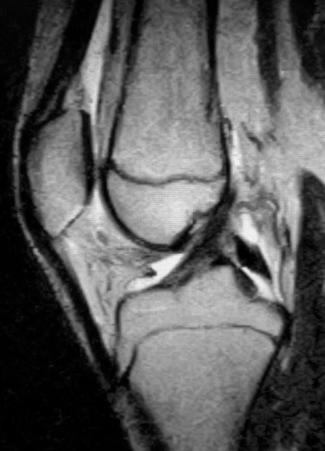
Pediatric joints have a higher percentage of cartilage than adult joints because of the physis and nonossified regions of the epiphysis, and this may explain the higher incidence of physeal and apophyseal fractures in the skeletally immature joints, such as the knee. Although occasionally seen in adults, tibial eminence avulsion injuries are relatively rare compared with midsubstance anterior cruciate ligament (ACL) injuries. Tibial eminence avulsion injuries are commonly seen in skeletally immature patients and may represent the fact that the epiphyseal region of the tibial plateau is composed of a relatively high percentage of cartilage compared with the adult knee ( Fig. 19.2 ). Avulsion injuries of the posterior cruciate ligament (PCL) are also seen in skeletally immature patients.
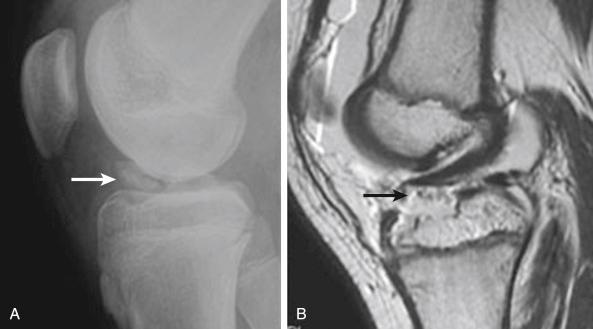
Pediatric bone is more flexible and less brittle than adult bone because of its decreased density. These different mechanical properties are evidenced by the unique fracture types seen in children, including buckle, bowing, and greenstick deformities.
Many studies of pediatric trauma have supported the concept that the physis is weaker than ligaments and that the physeal structure is more likely to fail than ligaments, especially under conditions of high-energy transfer. The weakest area of the physis is thought to be the zone of hypertrophy, although fractures can occur in other regions. Examples of fractures of this type include a medial epicondylar avulsion of the elbow, triplane fractures of the distal tibia, and traumatic displacement of the proximal femoral physis. These fractures are complicated by the susceptibility to growth disturbance after an injury, especially when physeal fractures are involved. Although these fracture patterns are relatively common in skeletally immature athletes, ligamentous injuries similar to those in adults can still occur in the skeletally immature.
Biomechanical studies of the physis and ligaments have shown that failure modes are related to the magnitude and rate of load application. Ligaments are more likely to fail at lower rates of load application, whereas physeal fractures are more likely to occur at higher rates of load application. The cartilaginous physes are approximately one-third as strong as their associated ligaments, and this difference becomes more disparate during growth spurts. As the child becomes older, the physis becomes stiffer and may make the incidence of a ligamentous injury more likely than a physeal injury.
The principles of examination (for the pediatric patient) are similar to those used for adults. Establishing trust and rapport with the child during the history (taking) will make the examination of a painful injury easier. It is often best to start away from the most painful site and work toward the injured area. Although serious injuries are rare, especially in smaller children, physeal and ligamentous injuries should always be considered. Thus, knowledge of physeal anatomy and the specific location of symptoms is needed to accurately diagnose these injuries. Often, the pediatric examination may be easier because of smaller joints and very distinct ligamentous end points. Some children naturally have increased laxity; therefore, comparison with the contralateral side is important. With knee examinations, Lachman test excursions may be easier to detect and quantify compared with adult patients. Specialized pediatric equipment, such as a KT-1000 Junior (MEDmetric, San Diego, California), may be helpful for these examinations. Historically, a complete examination was not thought to be possible without the use of sedation or anesthesia in some injuries. Because of the availability of current imaging technology, specifically MRI and computed tomography (CT), the need for examination under anesthesia is rarely necessary anymore.
Treating pediatric and adolescent patients is less complicated than treating adults in some respects. Children’s injuries tend to heal more quickly and are less apt to develop arthrofibrosis than adults. Younger patients generally require a shorter period of immobilization because of rapid healing. Adolescents and older patients with serious knee and other joint injuries are usually mobilized early to reduce the risk of arthrofibrosis. When arthrofibrosis does occur, in the authors’ experience, it tends to respond better to nonoperative measures in children than in adults. Thus, the treating physician may observe younger patients somewhat longer before considering surgical intervention in a stiff joint. In cases of severely ankylosed knees, Cole and Ehrlich described a successful approach for functional restoration in children. When manipulation is considered, caution is warranted because of the risk of physeal injury.
Diagnostic imaging is useful for serious injuries in young patients. Plain radiographs can identify osseous injuries, although they are inadequate for the evaluation of certain acute injuries such as a knee with hemarthrosis. Comparison views can be invaluable aids when physeal irregularities are being assessed. MRI seems to have replaced stress and nonstress radiographs in differentiating a physeal injury from a ligamentous injury.
MRI has been assessed as a mode of evaluation for the sports injury, especially in the knee. Imaging in children younger than 5 to 7 years may be limited because of the small size of the knee. The indications for MRI in children are still being established, although many clinicians rely on MRI for diagnosis. MRI is a very sensitive tool for the evaluation of physeal, osseous, and ligamentous structures. One significant limitation of MRI in skeletally immature patients is in the evaluation of meniscal tears: interpretation of meniscal tissue intrasubstance signal variation can be difficult because these younger patients frequently have variations in the meniscal signal, particularly in the posterolateral horn of the meniscus, that can suggest an injury in the setting of normal meniscal tissue. Kocher and colleagues and others have questioned the effectiveness and necessity of MRI for the routine evaluation of knee injuries in children, although imaging studies may help identify occult fracture or ligamentous injuries.
With regard to the rate of injuries found with the use of MRI, a recent study on the knee demonstrated that preadolescent patients with an effusion had patellar dislocations (36%), ACL tears (22%), and isolated meniscal tears (15%). Adolescent patients had slightly different rates of injury with knee effusion: ACL tears (40%), patellar dislocations (28%), and isolated meniscal tears (13%).
Shoulder pain is a common complaint among young athletes who perform overhead activities such as pitching, throwing, and swimming. The pain is usually located anteriorly, but lateral and posterior pain is not uncommon (especially as the dermal nerve distribution all comes from the axillary nerve). The pain is typically described as a dull ache, which occurs when they are performing their activities.
Examination of the shoulder consists of range-of-motion testing, a thorough neuromuscular assessment (particularly strength of the rotator cuff muscles), and specific diagnostic tests. Limits in range of motion may signal an acute injury, fracture, or dislocation. Occasionally, passive or active motion may help the child localize the pain. Weakness in a specific nerve distribution may indicate a cervical cause as the pain generator (either by radiculopathy or muscle imbalance). Weakness of the rotator cuff muscles will often lead to shoulder pain, especially with background joint laxity, because of excessive motion of the humerus in the glenohumeral joint. A differential diagnosis can usually be formulated after acquiring the history and performing the initial physical examination.
The sensitivity and specificity of clinical tests for superior labrum anterior/posterior (SLAP) lesions may be limited when used individually, but the diagnostic value may improve when several tests are used. In the assessment of SLAP tears, the O’Brien test, Biceps Load II test, Dynamic Labral Shear test (O’Driscoll test), Speed test, and the labral tension test have been assessed for predictability with very low yield to identify this injury pattern. Once the physical examination is complete, then confirmatory diagnostic testing may be performed.
Diagnostic testing involves plain radiographs of the shoulder that include anteroposterior (AP) and lateral projections. Depending on the differential diagnoses involved, this might include an axillary view, Velpeau axillary view, scapular Y view, AP shoulder with humerus internal and external rotation, Grashey view (true glenoid AP), or a serendipity view of the clavicle. After plain radiographs, there may be an indication for obtaining either MRI or CT scans. CT scans would be appropriate if a more detailed reconstruction of the bony architecture is required; however, for soft tissue injuries that cannot be evaluated by either a CT scan or a plain film, MRI is the diagnostic modality of choice, and often they are performed with an arthrogram to improve visualization of labral tears and partial undersurface tears of the rotator cuff tendon in children.
Shoulder injuries in the pediatric athlete are often because of instability, especially in sports with overhead movements and contact, such as football, rugby, wrestling, and basketball. Repeated overhead motions can stretch the joint capsule and allow excessive motion of the humeral head and contact to an actively abducted and externally rotated humerus places the glenohumeral joint at risk. Acute shoulder dislocation may result in stretching of the joint capsule or other glenohumeral pathology, such as labral tears (Perthes lesions), bony Bankart, glenolabral articular disruption lesions, partial articular sided rotator cuff tears (PASTA, or subscapularis tears), humeral avulsions of the glenohumeral ligaments, and anterior labroligamentous periosteal sleeve avulsions.
Historically, individuals 11 to 20 years old demonstrate approximately the same incidence of glenohumeral joint dislocation as their more mature counterparts 51 to 60 years old. However, this younger cohort may have more than a 70% chance of recurrent dislocation without surgical intervention. Pediatric dislocations are believed to stretch the capsule more than adult dislocations and diminish the capsule’s ability to provide the support needed for proper articulation. Surgical treatment for instability is generally successful and is often recommended, but the rate of recurrence in the adolescent population after either open or arthroscopic surgical repair may be as high as 10% to 24% at 2 years, with a 5-year survivability curve suggesting as high as 50% recurrent instability. The results of multidirectional instability surgery may be similar to pure anterior instability, with a recurrence of about 24% after surgical intervention in a young adult population. Isolated posterior instability fares no better in terms of outcomes, with 90% of children remaining stable after surgical intervention; but only about two-thirds able to return to preinjury level of play.
Physical examination and diagnostic testing may demonstrate the concomitant injuries of a Bankart lesion (anterior bony or labral tear), SLAP tear, Kim lesions (posterior sublabral pathology), Hill-Sachs (posterolateral humeral head compression fracture) lesions, rotator cuff muscle tears, and subscapularis or lesser tubercle avulsions. Recent evidence in the pediatric population suggests that preoperative evaluation and MRI underestimate the full extent of labral pathology seen at the time of arthroscopy.
An associated pathology to instability of the shoulder is internal impingement. There is a distinct difference between external impingement syndrome (formerly “impingement syndrome” of the shoulder) and internal impingement syndrome, with the former occurring in a more mature athlete or sedentary adult and the latter occurring almost exclusively in a younger athletic shoulder. The cause of internal impingement is believed to be multifactorial but occurs predominantly in overhead athletes (baseball, softball, volleyball, tennis, water polo, and swimming). Instability of the shoulder (even microinstability), especially with associated weakness to rotator cuff and periscapular stabilizers, posterior capsule contracture, and scapular dyskinesis, will cause scapulohumeral hyperangulation, scapular protraction, and ultimately contact of the humerus on the posterosuperior glenoid during activity. This contact then may result in partial articular surface tearing of the supraspinatus and infraspinatus tendon at their insertion on the humerus, as well as posterosuperior labral fraying and tearing. Early arthroscopic findings may be hypertrophic synovitis. MRI has been shown to underestimate the potential pathology seen in this overuse type injury, and therefore, inability to improve with conservative management may indicate surgical intervention.
In the acute care setting, dislocated shoulders should undergo closed reduction as quickly as possible. As previously discussed, children tend not to have favorable outcomes after shoulder dislocation: only 10% to 30% have success without surgical intervention. Surgical treatment for shoulder laxity, in the form of anterior, posterior, or multidirectional instability, may be delayed until a several-month period of physical therapy and activity modification has been attempted without significant clinical improvement. Should the child fail conservative management or have secondary laxity to a shoulder dislocation, at least a capsulorrhaphy may be required to create a stable glenohumeral joint. Other surgical treatments can be added à la carte, depending on the specific pathology present in each case. Recognition of osseous abnormality in the humeral head and/or glenoid may be an important factor associated with recurrent instability after surgery.
Suture anchors and plication of the redundant capsule appear to have the best outcomes from an arthroscopic approach. An open capsular shift through a standard deltopectoral approach remains the technique with the greatest reproducibility and results in the most postoperative stability. Outcomes for open procedures result in reported recurrent dislocation rates of 2.7% to 3.5% in adults as compared with arthroscopic results that range from 3.4% to 40%, depending on the study. Bottoni and colleagues conducted a randomized clinical trial of 66 patients and found comparable clinical outcomes between open and arthroscopic techniques for treating recurrent anterior shoulder instability. However, Lenters and colleagues published a systematic review and meta-analysis of reports comparing open and arthroscopic repairs for recurrent anterior shoulder dislocation and found that arthroscopic repairs were associated with significantly higher rates of recurrent instability, recurrent dislocation, and reoperation.
If the patient has bony defects in the glenoid or a Hill-Sachs lesion, these defects may be addressed by one of several procedures. These procedures include the Bristow procedure, the Latarjet procedure, and iliac crest bone grafting. To reduce the morbidity associated with autografting, recent techniques have used allograft from the femoral head and the distal tibia. These procedures are typically performed through an anterior open approach to the shoulder. Current techniques for arthroscopic Latarjet procedures have been developed but are technically demanding. Complications associated with the Latarjet procedure may be higher than those for arthroscopic procedures and include infection, neurologic injury, and recurrent dislocation.
Recent research is also studying the impact of humeral head defects, which, in some cases, may be a significant problem. Hill-Sachs deformities can also contribute to significant shoulder instability that cannot be addressed with a more traditional soft tissue and anterior Bankart repair. Techniques have been developed to prevent this posterior humeral defect from engaging the glenoid, which can cause shoulder disability and recurrent dislocation. These approaches address the humeral head defect by treating the osseous defects with bone supplementation. Techniques include allografting, humeral osteotomy, humeroplasty, and resurfacing arthroplasty. Soft tissue techniques have also been used and may include mobilizing the posterior aspect of the capsule and the infraspinatus tendon to fill the defect, termed “remplissage.” In cases of a traditional Bankart lesion combined with a significant Hill-Sachs deformity, this remplissage procedure may be combined with a Bankart repair via an arthroscopic approach ( Fig. 19.3 ). The presence of a significant glenoid defect may be a contraindication for this procedure, and other approaches may be necessary.
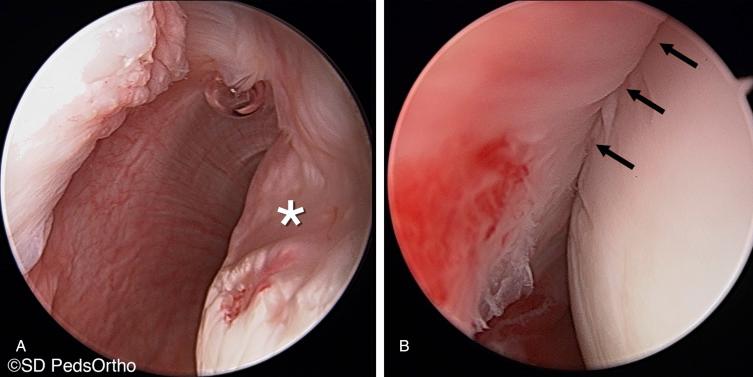
Future research comparing the outcomes of different osseous-based procedures will continue, and future arthroscopic techniques may eventually allow for correction of osseous and soft tissues deficits. A higher complication rate associated with these osseous procedures is a concern.
Internal impingement syndrome is treated with physical therapy that focuses on range of motion, periscapular strengthening, and activity-specific training that is integral to treatment and later prevention of reinjury in these young, aggressive athletes. Initial management should include activity modification in the form of rest, plus cryotherapeutic modalities and nonsteroidal antiinflammatory agents. If conservative management fails, then surgical treatment may be considered. The surgical treatment options vary based on the intraoperative findings and the suspected source of the internal impingement (instability, posterior capsular contracture, etc.). Either way, arthroscopy is the treatment of choice for débridement of PASTA tears less than 7 mm thickness, repairs of rotator cuff tears that are larger, débridement or repair of posterior labral pathology or synovitis, plus capsulorrhaphy in the setting of instability (anterior, posterior, or multidirectional) or capsular release for posterior contracture. ( Fig. 19.4 )
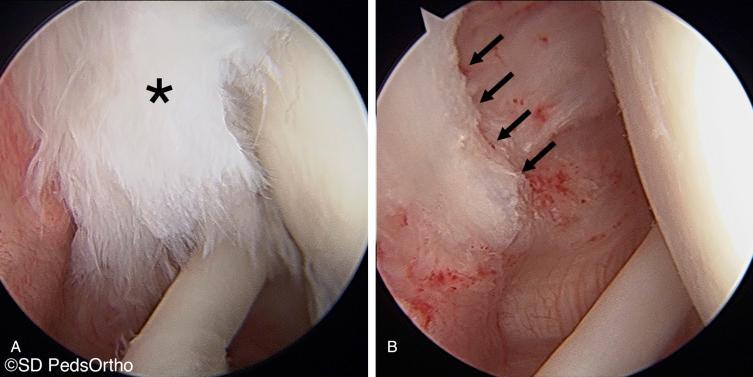
Adams was the first to describe Little Leaguer’s shoulder in boys 9 to 15 years of age. In the original description, the pathology was believed to be consistent with osteochondrosis of the proximal humeral epiphysis secondary to “an abnormal whip-like action, which places a forceful repetitious traction strain on the shoulder joint.” Since that time, a biomechanical study has demonstrated that 12-year-old baseball pitchers are able to consistently create 215 N of shoulder distraction force (about 50% of body weight) at ball release and 18 Newton-(N) meters of peak external rotation torque at the late arm-cocking phase. These forces, when consistently applied during the pitching motion of a young baseball player, are large enough to create deformation of the proximal physeal cartilage.
A stress fracture through the physeal plate may be the actual source of this Little Leaguer’s shoulder and the source of the symptomatic changes in the proximal physis of the humerus with repetitive baseball pitching. The first stage of this fracture is demonstrated by osteochondrosis, or epiphysiolysis, followed by widening of the physeal plate, and ultimately callus formation around the perichondral ring of LaCroix secondary to stripping of the periosteum. Advanced imaging techniques are consistent with biomechanical failure of the proximal humeral physis.
Stress fractures may occur along the entire shaft of the humerus, not just at the proximal growth plate. These metaphyseal and diaphyseal stress fractures are more likely to develop in adolescent overhead athletes, who have limited or no growth potential in their proximal humeral growth plate but who continue to have immature bone. The risk of development of this type of injury may also be increased by a concurrent period of rapid growth. An antecedent finding of stress fracture, or possibly a distinct entity, is humeral periostitis.
Little Leaguer’s shoulder, humeral periostitis, and humeral stress fractures have overlapping signs and symptoms, and pain of the proximal humerus and shoulder is often aggravated by the specific overhead activity that caused the pain and relieved with activity modification. The most common radiographic finding in Little Leaguer’s shoulder is widening of the proximal humeral epiphysis. Other findings may be demineralization, sclerosis, or fragmentation of the proximal humeral metaphysis. Stress fractures and periostitis may require a bone scan or MRI for definitive diagnosis, although the authors prefer the use of MRI because it avoids the use of radiation and offers much greater anatomic detail.
The treatment for Little Leaguer’s shoulder and stress fractures of the humerus is activity modification. Most often this involves rest and cessation of the offending activity for at least 4 weeks, followed by gradual resumption of pain-free activities over the next 4 to 8 weeks. Occasionally, physical therapy may be helpful for range of motion (in the form of teaching good throwing mechanics) and strengthening of the shoulder girdle musculature. If the child is not able to return to preinjury activity without pain, then the recommendation should be to stop that specific activity. This may mean cessation of the overhead sport or changing positions (on a baseball team) to one that is less demanding of the young athlete’s shoulder. Repeated imaging to confirm the health of the pathologic proximal humerus is debatable, if all symptoms have been resolved.
The young overhead athlete is vulnerable not only to shoulder injuries but also to traumatic and overuse elbow injuries. Injuries to the elbow are not limited to the overhead athlete, such as those engaged in throwing and swimming, but also include gymnasts, whose elbows, being weight-bearing joints during the sport, are also at risk. The elbow joint comprises three major articulations: radiocapitellar, ulnohumeral, and proximal radioulnar. Before understanding pathologic changes in the elbow, it is important to understand the normal ossification of the elbow through the six secondary centers. All of the ossification centers except the medial and lateral epicondyles are intraarticular. Injuries of the immature elbow have a predilection for involving the weaker growth plates, as compared with the bony or ligamentous structures.
The physical examination of the young elbow is most often led by the location of pain. Many of the structures involved in youth injuries are nearly subcutaneous, and the examination should include palpation of the medial epicondyle, olecranon, lateral epicondyle, and the radial head. Passive and active range of motion (i.e., flexion, extension, supination, and pronation) should be assessed, as well as varus and valgus stressing. Loss of motion, especially mild flexion contractures, occurs frequently. The elbow averages a clinical carrying angle of 7 degrees of valgus alignment. Muscle strength and any neurologic deficits should be recorded.
Radiographic findings are based on the standard AP, lateral, and oblique films of the elbow and often require contralateral elbow films for comparison. From AP radiographs, one can measure the Baumann angle (the angle created at the bisection of the capitellar physeal line and a line perpendicular to the humeral shaft), which should be within 8 degrees of the contralateral elbow. The lateral films should demonstrate a normal humerocapitellar angle of 30 to 40 degrees of flexion. More importantly, a line drawn along the anterior humeral shaft should bisect the center of the capitellum. Any view should be evaluated for fractures or dislocations, especially widening of the growth plates.
MRI studies of asymptomatic high school baseball players have demonstrated asymmetric anterior band ulnar collateral ligament thickening, mild sublime tubercle/anteromedial facet edema, and posteromedial subchondral sclerosis of the ulnotrochlear articulation, including posteromedial ulnotrochlear osteophytes and ulnotrochlear chondromalacia.
Fleisig and colleagues estimated that valgus forces at the elbow reach 64 N meters during late cocking and early acceleration phases of throwing, based on their biomechanics testing. Simultaneously, the compressive forces at the lateral radiocapitellar articulation, as the elbow arcs from 110 to 20 degrees of flexion at velocities of 3000 degrees/sec, may reach 500 N. The combination of these forces across the elbow joint may create a valgus extension overload that may become pathologic with repetitive throwing events. Valgus extension overload can result in most overhead sport-related injuries of the elbow because of the way the significant valgus loads, coupled with rapid elbow extension, produce tensile stress of the medial restraints, compression stress of the lateral compartment, and shear stress in the posterior compartment.
Medial elbow pain may represent an injury to the ulnar collateral ligament, flexor-pronator mass, medial epicondyle apophysis, or the ulnar nerve. In many cases of overuse elbow injuries, several of these injuries may coexist. Lateral elbow pain more likely represents an injury to the radial head or neck, lateral epicondyle apophysis, or capitellum. Posterior elbow pain usually represents an injury to the posteromedial tip of the olecranon or the trochlear and olecranon fossa.
Fractures of the medial epicondyle are more common than dislocations and account for approximately 10% of elbow fractures in children. Because of the physeal anatomy of the skeletally immature elbow, the ulnar collateral ligament and flexor muscles frequently avulse a fragment from the medial epicondyle. Elbow dislocations and fractures of the medial epicondyle are usually the result of falling with the forearm supinated and the elbow in full or partial extension. Nearly 50% of medial epicondyle fractures are associated with dislocation of the elbow, and often the displaced fragment becomes trapped in the joint, interfering with closed reduction of the dislocated elbow ( Fig. 19.5 ).
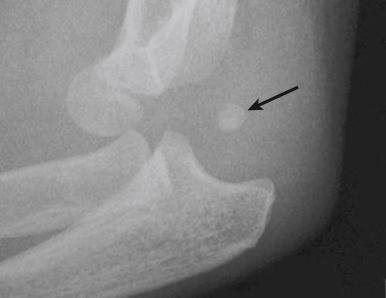
Medial epicondyle fractures and dislocations of the elbow are frequently seen in young gymnasts. Isolated medial epicondyle fractures are occasionally seen in adolescent pitchers. These injuries typically occur during the act of pitching and may be preceded by symptoms of medial epicondylitis. Both dislocations and overuse injuries can result in an ulnar collateral ligament injury.
A direct correlation of injury to the anterior bundle of the medial ulnar collateral ligament (ABMUCL) over years of extreme utilization (pitching since an early age) has been elucidated by ultrasound studies.
Evaluation and treatment of medial epicondyle elbow fractures continues to evolve. Radiographic analysis of fracture displacement has limitations, and more advanced imaging modalities may assist clinical decision-making. Treatment of medial epicondyle fractures is controversial, especially for minimally displaced fractures. Nondisplaced fractures are typically treated with casting, but displaced fractures may require surgery. In athletes who put high demand on their elbows (e.g., throwers, gymnasts, and wrestlers), anatomic reduction of medial epicondyle fractures may be important for future athletic performance; however, current literature suggests no difference in outcomes between surgical and nonsurgical cohorts.
Evidence has shown that ulnar collateral ligament reconstructions do well in the adolescent population, but there may be some evidence that success may be achieved with a direct repair in this younger population. The technique of reconstruction does not differ significantly in this age group compared with the skeletally mature; however, the technique for humeral fixation does need to take into account the open, or closing, medial epicondyle apophysis. Docking techniques can still be used, but it is the authors’ opinion that screw fixation is best so that it minimizes risk of disrupting the apophysis at its weakest time without anything more than suture fixation through a tunnel ( Fig. 19.6 ).
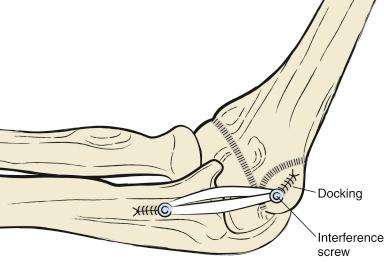
Overuse injuries of the immature elbow can all fall under one name, Little Leaguer’s elbow , and happen in 75% to 80% of all children playing baseball, with nearly one-third reporting psychological effects (not having fun) from the pain and 50% of them being encouraged to play through the pain. Klingele and Kocher described the various injuries that may be called Little Leaguer’s elbow, on the basis of the common etiology of repetitive microtrauma of the immature elbow ( Table 19.1 ).
| Little League Elbow Pathology | Diagnostic/Examination Findings |
|---|---|
| Medial epicondylar apophysitis | Tenderness at epicondyle |
| Osteochondritis dissecans (capitellum/ radial head) | Pain laterally, radiographic evidence |
| Traumatic and/or chronic avulsion of medial epicondyle | Pain at epicondyle, radiographic evidence |
| Anterior medial bundle ulnar collateral ligament injury | Pain with milking maneuver, pain at epicondyle or the sublime tubercle |
| Ulnar nerve subluxation/neuritis | Positive Tinel’s or evidence of subluxation with elbow flexion |
| Panner disease | <10 years of age |
Pain at the medial side of the elbow may be medial epicondyle apophysitis or an avulsion fracture. Radiographs will usually demonstrate physeal widening but may also demonstrate fragmentation of the ossification center. The elbow may appear to have a growth disturbance, represented by delayed ossification, or, contrarily, accelerated growth, marked by premature physeal closure. Occasionally, the physis is not the location of the pathology; instead, the injury may be to the ulnar collateral ligament or common flexor origin (golfer’s elbow in adults) or may be ulnar neuritis.
The lateral aspect of the elbow appears to demonstrate injuries involving the radiocapitellar joint rather than the lateral epicondyle (the source of “tennis elbow”). The capitellum may be the source of pain from osteochondrosis (Panner disease) or osteochondritis dissecans (OCD). It is important to differentiate between these two pathologic processes. The former occurs in younger children (<10 years) and is self-limited, and complete resolution is the norm after activity modification. The latter most often represents an osteochondral fracture in the older child or adolescent and often requires surgical intervention to achieve healing of the OCD and return to play.
If the capitellum is not the source of pain of the lateral elbow, then the radial head may be the cause. The radial head may also be subject to OCD lesions, which may be difficult to assess on plain radiographs. The radial neck may be subject to deformation that can lead to poor elbow mechanics and pain.
Posterior elbow pain most often represents an injury to the olecranon apophysis, an avulsion fracture, or delay of apophyseal fusion. Comparison of contralateral films may be helpful. MRI has proven itself nearly essentially in the workup in elbow pathology, because of the complex anatomy. The ability to determine the characteristics of an OCD lesion within the capitellum is almost impossible without an MRI, in that it can help determine the precise location of the lesion on the capitellum (is it a “shoulder lesion”?), and it can discern the stability of the lesion. This information greatly influences the recommended treatment and is essential to preoperative planning. With valgus extension overload, the compression stress on the posteromedial olecranon can create osteophytes. The osteophytes may then lead to bony extension contracture; it is important to realize that the osteophytes are a by-product of the pathology.
On occasion, Little Leaguer’s elbow may include anterior elbow pain and pathology that is secondary to the valgus extension overload. This usually comes in the form of anterior-based capsular contractures that cause a flexion contracture of the elbow.
Initial management of Little Leaguer’s elbow is conservative and nonsurgical unless the diagnosis is that of a fracture. Activity restrictions, therapy, and change to another position that requires less throwing are all options that help with healing. Medial epicondyle fractures or olecranon stress fractures, for example, may require open reduction and internal fixation (ORIF) for predictable outcomes in some athletes. The other scenario that calls for initial management to be operative is the finding of loose bodies within the joint, because the pain is unlikely to resolve without excision.
The initial nonoperative management, whether started for medial epicondyle apophysitis, an ulnar collateral ligament injury, or any of the other manifestations of valgus extension overload syndrome, is the same regimen independent of the diagnosis. The first step in management is cessation of provocative activities for at least 4 to 6 weeks, with concurrent cryotherapeutic and antiinflammatory modalities. Cessation of all throwing until the elbow is asymptomatic with reassessment of throwing mechanics and number of pitches thrown is essential. During the rest from throwing activities, a transition into physical therapy that begins with regaining motion and strengthening the shoulder girdle, scapular stabilizers, and rotator cuff musculature should be started. Poor mechanics of the shoulder may increase the pathologic stresses across the elbow during the throwing motion. Once the symptoms of pain begin to wane with this physical therapy program, strengthening of the medial flexor-pronator muscles may commence. Finally, with complete resolution of pain, a controlled regimen of activity-specific exercises, plyometrics, and an interval throwing program is undertaken before return to competitive activities. The duration of this program often extends beyond 4 to 6 months if done appropriately (with the throwing program itself taking 3 to 4 months to complete). Families should be encouraged to stay true with the program for the health of their child’s elbow. Plus, the concept of pitch counts often requires re-education (it includes every league played concurrently and the use of a pitching coach).
It is important to realize that nonoperative treatment of ABMUCL injuries is generally indicated in nonthrowing athletes because good outcomes can be achieved; in contrast, patients who are involved in high-demand overhead sports (throwing, volleyball, tennis, javelin) do not respond as well to nonoperative management. Therefore, differentiating between a true ligament tear and incompetency versus medial epicondyle apophysitis or avulsion is important. If, indeed, the child is given a diagnosis of a tear in the ABMUCL and still wishes to continue competitive pitching, then the treatment of choice after failed conservative management may be ulnar collateral ligament reconstruction.
The best treatment for many of these injuries may actually be prevention. This means teaching children good mechanics and, in throwing sports, limiting the number of pitches. Current recommendations for the number of pitches per game differ with the age of the child: 7- to 8-year-old athletes are limited to 50 pitches, 9- to 10-year-old athletes are limited to 75 pitches, 11- to 12-year-old athletes are limited to 85 pitches, 13- to 16-year-old athletes are limited to 95 pitches, and 17- to 18-year-old athletes are limited to 105 pitches.
Lateral elbow pain is treated in the same manner as medial and posterior elbow pain. Nonoperative management with activity modifications and physical therapy directed in a similar fashion to the medial elbow should be attempted first, and the focus should initially be on the shoulder, but then followed by the lateral forearm extensor mass. Failure of this regimen may require arthroscopic débridement, chondroplasty, microfracture, or removal of loose bodies, as needed, especially if an OCD lesion with a loose fragment is the cause. The utilization of osteochondral plugs to replace the diseased part of the capitellum has been met with success and return to sports, especially for unstable capitellum OCD ( Fig. 19.7 ).
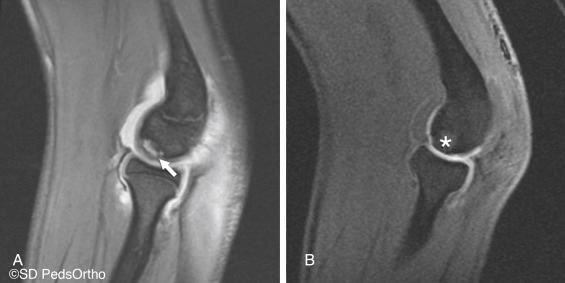
Posterior elbow pain, especially in the form of a stress fracture or olecranon apophysitis, can be treated successfully with surgery. A technique that percutaneously places a screw across the apophysis, creating compression, has been demonstrated to have success and achieve early return to sports. But initial nonoperative management (as discussed above) should still be considered first-line treatment in this injury pattern to avoid the complications of surgery and need for secondary surgery to remove the implant.
Wrist pain in an overhead-throwing athlete is not as common as that of pain in the elbow or shoulder. In contrast to throwers, gymnasts have a much higher incidence of wrist pathology. Chronic wrist pain is estimated to affect nearly 80% of all child gymnasts at one time or another because of the way that the wrist becomes a weight-bearing joint. The younger the child begins training for gymnastics, the more likely that the growth plates surrounding the wrist are potential sites of injury.
Other children at risk of developing wrist pain are those using bats, rackets, or their hands to strike a ball. Most often, these injuries are considered acute and may involve fractures of the carpal bones, especially the scaphoid and hook of the hamate. Repetitive striking of the volleyball has been implicated as a potential cause of Keinböck avascular necrosis of the lunate.
Examination of the wrist should involve a thorough neuromuscular assessment, evaluation of range of motion, and location of the pain. Pain in the anatomic snuff box may indicate a scaphoid fracture, pain over the radial styloid is more consistent with distal radial pathology, and pain near the ulnar styloid may represent a tear of the triangular fibrocartilage complex (TFCC).
Radiographs should consist of AP and lateral wrist or hand views, as well as specialized views depending on the differential diagnosis; these may include a carpal tunnel view to evaluate the hook of the hamate and contralateral wrist views to help assess growth plate injuries. Depending on the differential diagnosis, MRI may be performed to exclude nondisplaced fractures or osteonecrosis of the carpals. Furthermore, MRI or a CT scan, depending on the information desired, may be obtained to better evaluate wrist pathology. Often, TFCC tears and chondral lesions may be missed even on MRI.
Gymnast wrist has been defined as chronic radial pain with the following radiographic findings: growth plate widening with “haziness” or ill-defined borders, metaphyseal cyst formation, and epiphyseal beaking. Some evidence has shown that these changes may result in premature physeal closure of the distal radius. Albanese and colleagues further postulated through a summary of previous studies that some repetitive compression loading of a physis may result in increased growth, whereas too much repetitive compression loading will inhibit growth and possibly result in physeal arrest. Therefore, the etiology of gymnast risk is unclear (given the widening of the physis but the risk of arrest) in this population of athletes who are using their wrists in a weight-bearing fashion. It is important to note that 70% of all gymnasts will experience some form of wrist pain in their young careers.
Past MRI study demonstrated that not all gymnasts sustain classic gymnast wrist. Dwek and colleagues did find chronic physeal changes consistent with gymnast wrist, but more importantly, they discovered focal lunate osteochondral defects, TFCC tears, scapholunate ligament tears, and metacarpal head flattening and necrosis in the group of adolescent teenagers they studied.
Scaphoid fractures have also been reported to occur in gymnasts, and surgical treatment may be necessary in some cases.
The mainstay of treatment of gymnast wrist is activity modification, specifically cessation of wrist weight-bearing activities. Physical therapy with cryotherapy and antiinflammatory management may be undertaken during this period of rest in an effort to accelerate recovery time and ensure prevention of reinjury. Children should not be allowed to return to competitive activities unless they are pain free and are able to remain that way during activity.
If nonoperative management fails, then a few operative choices may be considered. Depending on the preoperative findings, an ulnar shortening osteotomy may be performed if positive ulnar variance is found; a chondroplasty or arthroscopic débridement of loose bodies or synovitis may also be done to alleviate symptoms. The results of operative management are good in terms of pain relief, but oftentimes the symptoms will return with competitive activities.
Gymnasts and other athletes are also prone to ligamentous injuries and injuries to the TFCC because of repetitive weight-bearing on the wrist, as mentioned above in the imaging studies. Other young athletes (such as those participating in basketball, lacrosse, or baseball) may also be susceptible to these soft tissue injuries. Tears of the TFCC may result in further damage to the adjacent articular cartilage if the offending activity is not stopped. Chondromalacia has been found to involve the ulnolunate, ulnotriquetral, and radiocarpal joints.
A recent study on ulnar-sided wrist pain demonstrated many possible causes in the athletic population. Fractures of the ulnar styloid, hamate, pisiform, and base of the fifth metacarpal may be present; in addition, soft tissue injuries consistent with ulnar impaction syndrome, extensor carpi ulnaris disorder, or even flexor carpi ulnaris disorders may be causes.
Become a Clinical Tree membership for Full access and enjoy Unlimited articles
If you are a member. Log in here